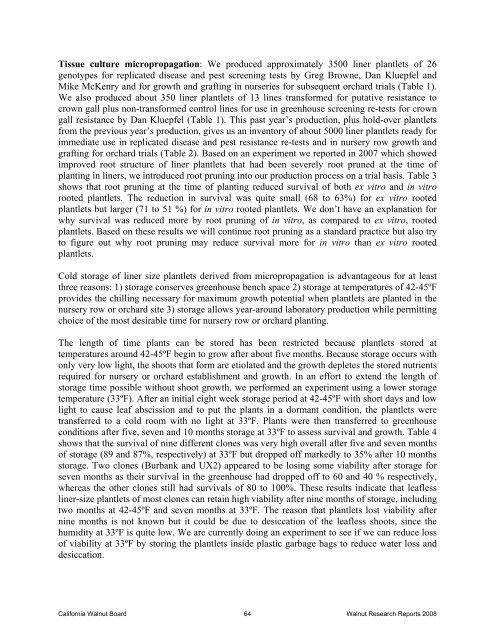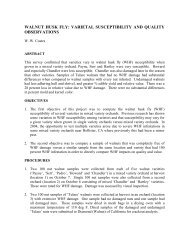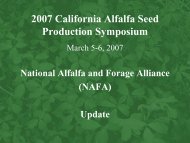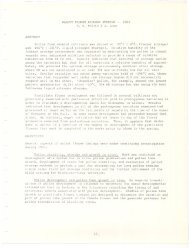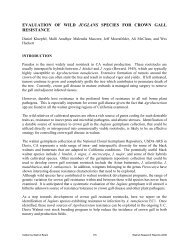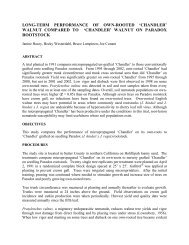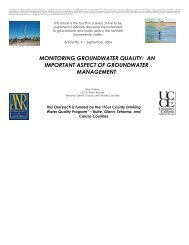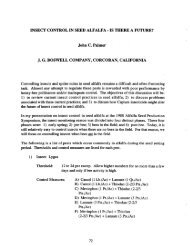clonal propagation of walnut rootstock genotypes for genetic ...
clonal propagation of walnut rootstock genotypes for genetic ...
clonal propagation of walnut rootstock genotypes for genetic ...
You also want an ePaper? Increase the reach of your titles
YUMPU automatically turns print PDFs into web optimized ePapers that Google loves.
Tissue culture micro<strong>propagation</strong>: We produced approximately 3500 liner plantlets <strong>of</strong> 26<strong>genotypes</strong> <strong>for</strong> replicated disease and pest screening tests by Greg Browne, Dan Kluepfel andMike McKenry and <strong>for</strong> growth and grafting in nurseries <strong>for</strong> subsequent orchard trials (Table 1).We also produced about 350 liner plantlets <strong>of</strong> 13 lines trans<strong>for</strong>med <strong>for</strong> putative resistance tocrown gall plus non-trans<strong>for</strong>med control lines <strong>for</strong> use in greenhouse screening re-tests <strong>for</strong> crowngall resistance by Dan Kluepfel (Table 1). This past year’s production, plus hold-over plantletsfrom the previous year’s production, gives us an inventory <strong>of</strong> about 5000 liner plantlets ready <strong>for</strong>immediate use in replicated disease and pest resistance re-tests and in nursery row growth andgrafting <strong>for</strong> orchard trials (Table 2). Based on an experiment we reported in 2007 which showedimproved root structure <strong>of</strong> liner plantlets that had been severely root pruned at the time <strong>of</strong>planting in liners, we introduced root pruning into our production process on a trial basis. Table 3shows that root pruning at the time <strong>of</strong> planting reduced survival <strong>of</strong> both ex vitro and in vitrorooted plantlets. The reduction in survival was quite small (68 to 63%) <strong>for</strong> ex vitro rootedplantlets but larger (71 to 51 %) <strong>for</strong> in vitro rooted plantlets. We don’t have an explanation <strong>for</strong>why survival was reduced more by root pruning <strong>of</strong> in vitro, as compared to ex vitro, rootedplantlets. Based on these results we will continue root pruning as a standard practice but also tryto figure out why root pruning may reduce survival more <strong>for</strong> in vitro than ex vitro rootedplantlets.Cold storage <strong>of</strong> liner size plantlets derived from micro<strong>propagation</strong> is advantageous <strong>for</strong> at leastthree reasons: 1) storage conserves greenhouse bench space 2) storage at temperatures <strong>of</strong> 42-45ºFprovides the chilling necessary <strong>for</strong> maximum growth potential when plantlets are planted in thenursery row or orchard site 3) storage allows year-around laboratory production while permittingchoice <strong>of</strong> the most desirable time <strong>for</strong> nursery row or orchard planting.The length <strong>of</strong> time plants can be stored has been restricted because plantlets stored attemperatures around 42-45ºF begin to grow after about five months. Because storage occurs withonly very low light, the shoots that <strong>for</strong>m are etiolated and the growth depletes the stored nutrientsrequired <strong>for</strong> nursery or orchard establishment and growth. In an ef<strong>for</strong>t to extend the length <strong>of</strong>storage time possible without shoot growth, we per<strong>for</strong>med an experiment using a lower storagetemperature (33ºF). After an initial eight week storage period at 42-45ºF with short days and lowlight to cause leaf abscission and to put the plants in a dormant condition, the plantlets weretransferred to a cold room with no light at 33ºF. Plants were then transferred to greenhouseconditions after five, seven and 10 months storage at 33ºF to assess survival and growth. Table 4shows that the survival <strong>of</strong> nine different clones was very high overall after five and seven months<strong>of</strong> storage (89 and 87%, respectively) at 33ºF but dropped <strong>of</strong>f markedly to 35% after 10 monthsstorage. Two clones (Burbank and UX2) appeared to be losing some viability after storage <strong>for</strong>seven months as their survival in the greenhouse had dropped <strong>of</strong>f to 60 and 40 % respectively,whereas the other clones still had survivals <strong>of</strong> 80 to 100%. These results indicate that leaflessliner-size plantlets <strong>of</strong> most clones can retain high viability after nine months <strong>of</strong> storage, includingtwo months at 42-45ºF and seven months at 33ºF. The reason that plantlets lost viability afternine months is not known but it could be due to desiccation <strong>of</strong> the leafless shoots, since thehumidity at 33ºF is quite low. We are currently doing an experiment to see if we can reduce loss<strong>of</strong> viability at 33ºF by storing the plantlets inside plastic garbage bags to reduce water loss anddesiccation.Cali<strong>for</strong>nia Walnut Board 64 Walnut Research Reports 2008


